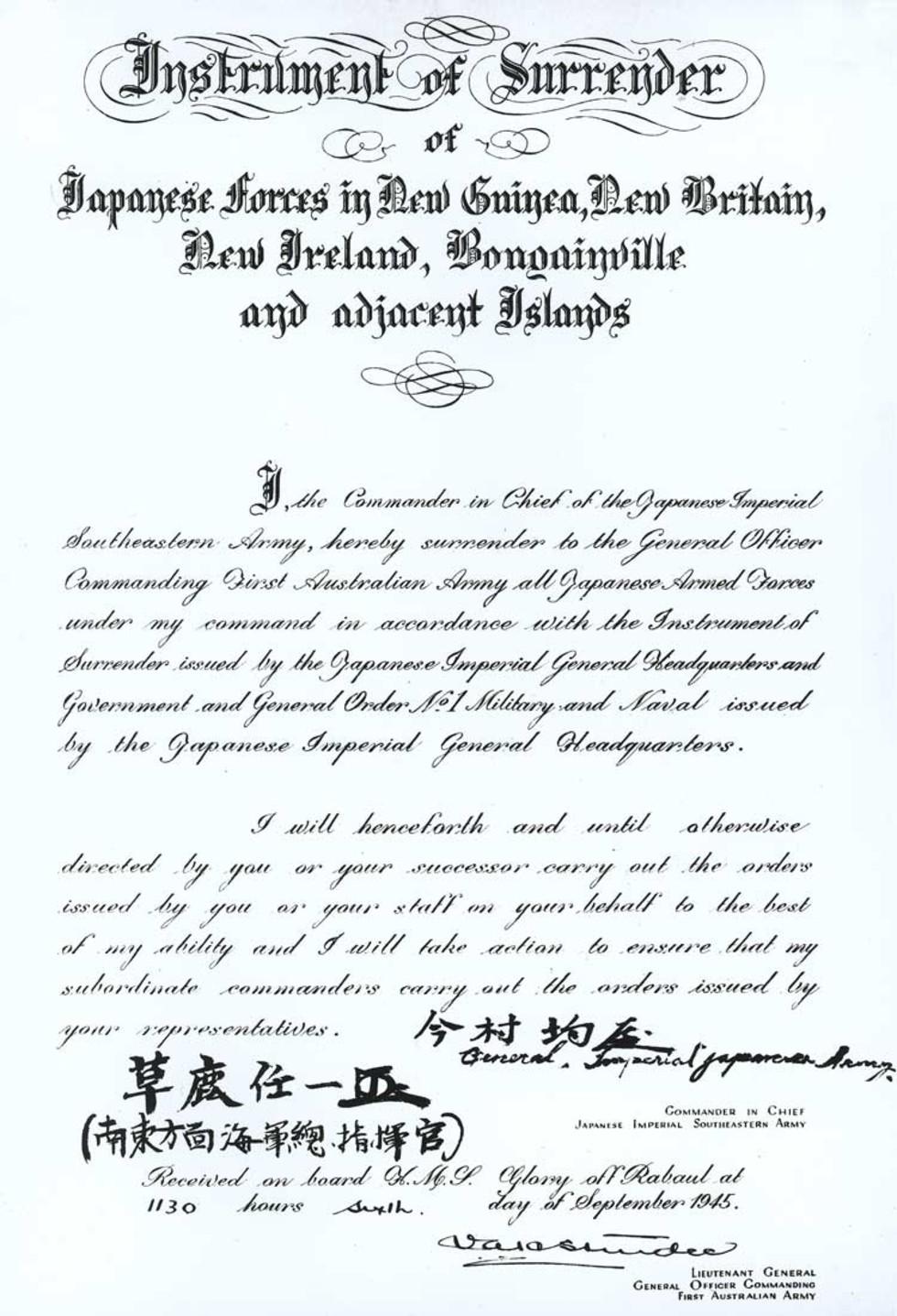


Transcript
[Heading in elaborate Gothic script] Instrument of Surrender of Japanese forces in New Guinea, New Britain, New Ireland, Bougainville and adjacent Islands.
I, the Commander in Chief of Japanese Imperial Southeastern Army, hereby surrender to the General Officer Commanding First Australian Army all Japanese Armed Forces under my command in accordance with the Instrument of Surrender issued by the Japanese Imperial General Headquarters and Government and General Order No. 1 Military and Naval issued by the Japanese Imperial General Headquarters.
I will henceforth and until otherwise directed by you or your successor carry out the orders issued by you or your staff on your behalf to the best of my ability and I will take action to ensure that my subordinate commanders carry out the orders issued by your representatives.
[Signature of General Hitoshi Imamura]
General. Imperial Japanese Army.
[Japanese script]
Received on board H. M. S Glory off Rabaul at 1130 hours sixth day of September 1945.
[Signature of Lieutenant General Vernon Ashton Hobart Sturdee]
Lieutenant General
General Officer Commanding
First Australian Army
About this record
This document is a Second World War Instrument of Surrender by Japanese Forces in New Guinea, New Britain, New Ireland, Bougainville and adjacent islands. It is signed by Lieutenant General Vernon Sturdee (1890–1966), General Officer Commanding First Australian Army and Commander in Chief of the Japanese Imperial Southeastern Army, General Hitoshi Imamura (1886–1968). The signing took place on board the aircraft carrier HMS Glory off the coast of Rabaul on the island of New Britain on 6 September 1945.
Educational value
- This Instrument of Surrender is one of a number of surrender documents signed by representatives from Japanese and Allied forces in various areas across the Asia–Pacific region at the end of the the Second World War. On 15 August 1945 the Emperor of Japan formally announced his nation’s acceptance of the terms of surrender drafted at the Potsdam Conference signalling an official cessation of hostilities.
- The document was signed four days after the primary surrender ceremony in Tokyo Bay, in accordance with the orders of General Douglas MacArthur (1880–1964), Supreme Commander of Allied Forces in the South-West Pacific area. MacArthur ordered that no landings proceed or surrender documents be signed across the South-West Pacific until after the main ceremony on 2 September 1945, causing frustration for Australian forces anxious to liberate prisoners of war from Japanese strongholds.
- The port of Rabaul was an important strategic location for Japanese forces in the Pacific due to its proximity to New Guinea and the Japanese-mandated Caroline Islands. In January 1942 Rabaul was the first Australian territory to be attacked by the Japanese. More than 1000 Australians were captured there. Many lost their lives when a United States submarine sank the Montevideo Maru – a Japanese ship transferring Australian prisoners of war to Hainan Island in China.
- Nearly 70,000 Japanese servicemen and 20,000 civilians surrendered at Rabaul to the Australian forces and were interned on the island before being repatriated over the next two years. They were required by Sturdee to construct internment camps and to maintain the self-sufficiency efforts developed after communication with Japan was cut in 1943. This minimised the supplies needed to maintain them and saved Australian resources and supplies.
- The signatory to this document, Commander in Chief of the Japanese Imperial Southeastern Army General Hitoshi Imamura, was detained at Rabaul before being tried in 1946 by the International Military Tribunal for the Far East set up by General Douglas MacArthur. Imamura was found guilty of committing war crimes in violation of the Geneva and Hague Conventions. He was sentenced to ten years imprisonment and released in 1954.
Acknowledgments
Learning resource text © Education Services Australia Limited and the National Archives of Australia 2010.
Related themes
Need help with your research?
Learn how to interpret primary sources, use our collection and more.


